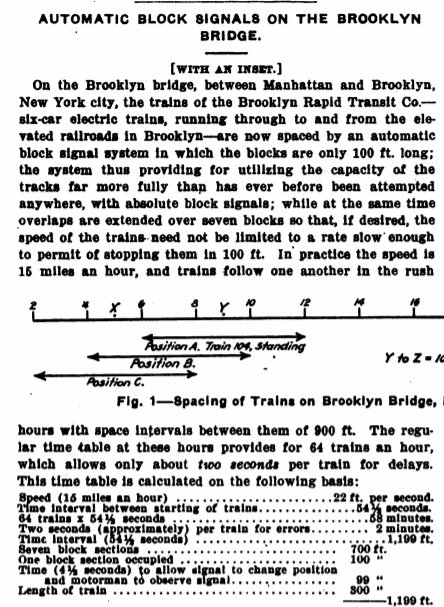At its peak, the elevated line to Park Row was a hell of an operation. It ran *sixty four* trains per hour at peak, a throughput unheard of pretty much anywhere today. This was achieved through an awesome combination of station design and low-tech CBTC. https://twitter.com/NYTransitMuseum/status/1331621958954455040">https://twitter.com/NYTransit...
On the front of station design, note that the stations on either end of the bridge had multiple platforms feeding the bridge tracks. This meant that you could have a train pulling out of the station while another was loading, and yet another was pulling in.
This, in effect, reduces the negative effect station dwell times have on capacity -- a strategy deployed on modern systems, too! https://twitter.com/A320Lga/status/1330048411261939719?s=20">https://twitter.com/A320Lga/s...
On the Manhattan end, the presence of many platforms was used by the BMT to create designate loading zones for trains serving each of its lines in Brooklyn, allowing more orderly boarding.
(Both maps from "Tracks of New York 2" by Kahn)
(Both maps from "Tracks of New York 2" by Kahn)
But, of course, in between these stations lay the bridge itself, and for this all to work, you had to manage that extremely high frequency operation well. The secret to it seems to have been the signal system.
BMT& #39;s signal engineers divided the bridge into a series of 100 foot blocks of track, each of which could & #39;tell& #39; if a train was occupying it. These blocks, and the signals governing them, were designed to keep trains 900 feet apart while crossing the span, and
through their short length, allowed for & #39;high resolution operations& #39; -- ie you knew train positions +/- 50 feet, an unusually high precision relative to more normal fixed-block signal systems.
Prev screencap from: #v=onepage&q&f=false">https://www.google.com/books/edition/Railroad_Age_Gazette/GWQgAQAAMAAJ?hl=en&gbpv=1&dq=brooklyn+bridge+signal+system+800&pg=PA806&printsec=frontcover #v=onepage&q&f=false">https://www.google.com/books/edi...
Prev screencap from: #v=onepage&q&f=false">https://www.google.com/books/edition/Railroad_Age_Gazette/GWQgAQAAMAAJ?hl=en&gbpv=1&dq=brooklyn+bridge+signal+system+800&pg=PA806&printsec=frontcover #v=onepage&q&f=false">https://www.google.com/books/edi...
This, of course, reduces the lag between the train ahead of you moving forwards and your train being able to do the same: the shorter the block, the faster that motion will translate into a signal change.
CBTC is basically this principle extended to infinity: by continuously communicating train position, you can remove a lot of the lag associated with the intermittent control and low resolution inherent to fixed-block systems (on this front, and others).
Anyway, this high-intensity operation on the Brooklyn Bridge lasted for only a few years; as subways opened btwn Bk and Manh, the line fell from favor, and as @NYTransitMuseum tweeted, was abandoned in 1944.

 Read on Twitter
Read on Twitter




